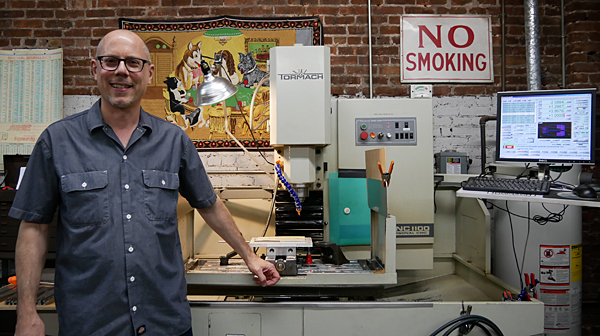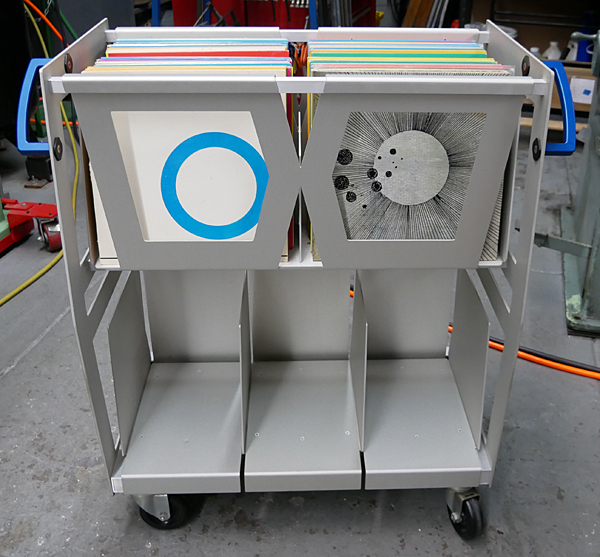| Columns Retired Columns & Blogs |
Nice coverage and interesting products- RB.
which locations of apt(s) did you guys move? Why?
Otherwise, I would like to read about a company in similar form that makes CD storage wares. Happy Listening!
For LP collectors who have spaces where modularity is not a concern, Urbangreen also builds larger record cabinets that can be anywhere from two to five shelves high ($239–$789). Each bay holds 60–70 LPs. They can also make shelves for CDs, DVDs, and other physical media. Custom work for bigger jobs, which Didaskalou says are the bulk of his business, is also available. He's covered entire walls of New York apartments with LP shelves.
"Everybody has their specific needs, and we are happy to participate in them. All of our shelves have adjustable metal feet, so that you can balance your LP shelf on any surface. In New York, for example, most of the floors are crooked."
One of the more intriguing things about Urbangreen is that its manufacturing facility is in the Brooklyn Army Terminal, on the water in Sunset Park. Built in 1919 of huge steel-reinforced slabs of concrete, this 4-million-square-foot supply depot was designed by architect Cass Gilbert, who designed the Woolworth Building, in lower Manhattan. Used to embark over 3.2 million men and 37 million tons of supplies during WWII, it's also the last place PFC Elvis Presley saw in the US before sailing to Germany. The City of New York bought the Terminal from the US Government in 1981, and it's now managed by the New York City Economic Development Corporation. Inside are more than 70 businesses employing 2500 people, doing everything from art and electronics to the NYPD and environmentally sound furniture manufacturing.
Best of all, with its concrete balconies, and multiple train tracks running through the middle of the building and straight out to the docks of New York Harbor (the building once had 96 elevators to transport supplies and ammunition), the Terminal has a fantastically weird postapocalyptic feel—it's a readymade set for a futuristic horror film.
In contrast to that is Brooklyn's other maker of LP shelves, Wax Rax. When I first read the address, then looked it up on Google Maps, I thought my eyes were deceiving me. Owned by David Stanavich, Wax Rax is headquartered in a smallish industrial space on the edge of Park Slope, one of Brooklyn's most expensive neighborhoods.

Stanavich, originally from Amsterdam, New York, began his journey to making LP shelves at Pratt Institute, in Clinton Hill, Brooklyn—where, he now says, his goal was to see himself and his creations in the magazine Art in America. Interested in metalwork, the high-energy Stanavich worked summers at a tool-and-die shop in upstate New York. After graduating from Pratt, he worked at various metalworking and fabricating studios in New York City for 12 years before starting his own business in 2003, in a 4000-square-foot building on Prospect Park South. He and his wife live upstairs, above the industrial space.
"It was right after 9/11, and people were dumping and running. We had been looking for about a year prior, and we decided, no matter what, we were gonna stay in the city, and so it just happened."
Stanavich's business began life as Brooklyn Custom Metal Fabrication, in which he worked with architects, designers, and institutions, making custom furniture, sculptures, and windows. During those years he made prototype benches for the Highline in Manhattan, and a large metalwork art installation for the Chinese embassy in Washington, DC.
"At the 10-year mark of Brooklyn Custom, I said to my wife, 'We're helping people go to market with their furniture designs, we're prototyping stuff—why don't we do our own?' But there were a hundred companies making dining-room tables and chandeliers. It's not that I couldn't hack it, but I thought, 'Wow, we're just going to be awash!' So one frustrated evening, I was playing some records, and I said, 'Wait a minute . . .'"
Stanavich began by making a wheeled metal cart for LPs for himself. Then he looked at the progression of shelving that most LP collectors go through in their lives: milk crates, cinder blocks and planks, and then the inevitable IKEA shelves. Before the resurgence of the LP, he began selling carts that rolled on wheels, like the one he'd made for himself. He worked for a year "in secret," he says, getting his designs together and his patent and trademark applications filed. He also began showing his wares at design shows. The response from potential buyers at the 2013 edition of the WFMU Record Fair, which the Jersey City, New Jersey, radio station hosts as well as the 2014 New York Audio Show, in Brooklyn, convinced him he was on the right track.

Much to his amusement, he soon learned that catering to the audiophile community had its quirks. He found that the props he was using to display his shelves were attracting a lot of attention. "In 2015, I used an Allied receiver—just the box, the guts were gone—and a Thorens turntable that didn't work, and I spent way too much time talking about the gear. In 2016, I used a completely fake system with a real Garrard platter and tonearm, and a couple people still asked about purchasing the gear."
Convinced that aiming his products at the LP collectors' market was the correct strategy, he began to expand his product line. "The carts were selling to people who had lofts, urban loft situations, or converted basements that had been turned into listening rooms. But then I heard, 'Hey, the carts are great, but I have carpet' or 'I have stairs.'"
Stanavich now makes five different models: from the RC-2 cart, which holds 400 LPs ($1525), to the LP-H console, which has shelves for a turntable and electronic components, and bins and shelves for LPs (starting at $7000). For larger collections, there's the three- or four-shelf LP-V, which holds 700 LPs (starting at $5000). There's also a 45 Record Adapter ($20), and a Now Playing record-cover stand ($60) for propping up the jacket of whatever LP is currently spinning on the platter. All of Stanavich's shelves are available in anodized aluminum (the better seller) or, in the larger units, powder-coated steel. The RC-2 cart and the larger shelves are welded; all other Wax Rax models are mechanically fastened with industrial-grade aircraft rivets. The best seller is still Stanavich's original RC-2 cart, which he says compares in price to a good ten-speed bicycle. While he sells out of his shop and via his website, he says he has dealer interest in the US, Australia, and the UK.
"A lot of people say 'record storage,' but my feeling is, you put books in a box and you don't read them. This is about vinyl access. The functionality is forward-facing sections where you can flip through the collection, or a selection of your collection. Two hundred records—that's nearly two hundred hours. If you load up the top portion of one of my carts you're going to have months of enjoyment."
Stanavich is a dedicated music fan and budding audiophile. "It started in 1975, when I bought my first single. My tastes are everything from the blues to punk rock, heavy metal, jazz, reggae, alternative, classical, country. I really like parts of just about everything."
These two companies have greatly benefited from the unexpected resurgence of the LP. "I like to create," Elias says, "I like to see tangible creations. And make people happy."
Stanavich, also riding the new LP wave, says, "It's working and growing every year, and I'm really thrilled about that."

Nice coverage and interesting products- RB.
which locations of apt(s) did you guys move? Why?
Otherwise, I would like to read about a company in similar form that makes CD storage wares. Happy Listening!

I had one of those album collections that meant it took 20 minutes or more to decide what to put on the turntable next, and went through several different storage strategies. The real problem I eventually had though wasn't how to store them... it was how to have a house that could survive them.
A new construction house we bought in the Maryland suburbs (in the 90s) was built to the county's minimum construction specs. Our record collection did permanent damage to the floor - including to the floor supports - in our family room that eventually required some very creative repair and remediation so that stuff didn't fall off our shelves when someone walked across the room. Got to where people felt uncomfortable and nervous standing in the room when someone walked across it.
I'll say this for digital music, it's never going to cause me to pay thousands of dollars to a carpenter to fix my floors. My LP collection now lives in its lovely racks on the concrete basement floor.